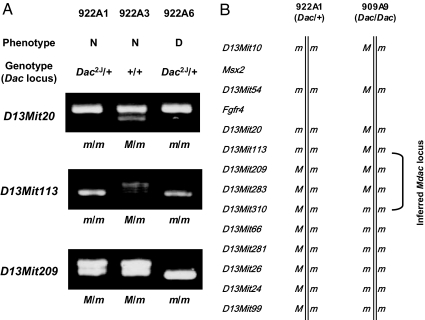Fig. 4.
Mapping of Mdac on mouse chromosome 13. F1 hybrids (Dac/+ Mdac/mdac) were produced by crossing the dactylaplasia mouse (Dac/+ mdac/mdac) and C57BL/6J (+/+ Mdac/Mdac) and then backcrossed to the dactylaplasia parental strain. These backcrosses were typed for both Dac and microsatellite markers on chromosome 13, and phenotypes were compared. (A) Recombination between D13Mit113 and D13Mit209 in a mouse 922A1. The mouse 922A1 exhibited normal phenotype despite carrying the Dac2J mutant allele. Microsatellite markers that were homozygous (D13Mit20 and D13Mit113) were excluded from the Mdac locus because this mouse must have the Mdac allele. N, normal; D, dactylaplasia; m, allele inherited from the dactylaplasia parental strain; and M, allele inherited from the C57BL/6J strain. (B) Recombination events in two offspring (922A1 and 909A9) placed Mdac within a 9.4-Mb interval region between D13Mit113 and D13Mit310. Both offspring exhibited a normal phenotype despite carrying the Dac mutant allele, indicating the presence of Mdac.

